Long head biceps exercises train the portions of your “bis” that give your upper arms their “peak.”
In this article, you’ll discover exactly what the biceps long head is, why training it is important, how to target your long head with weight training, the best long head biceps exercises to include in your workouts, an example workout for the long head of your biceps, and more.
Table of Contents
+
What Is the Long Head of the Biceps?
The biceps brachii, or “biceps,” is the muscle group located on the front of the upper arm between the shoulder and elbow.
It has two heads:
- The long head: The biceps long head is located towards the outside of the upper arm and gives the appearance of a “peak” when flexed. It flexes the elbow (bends the elbow to bring the hand to the shoulder), supinates the forearm (twists the forearm to face the palm upward), and assists shoulder flexion (raising the arm from the side overhead).
- The short head: The short head of the biceps is on the inside of the upper arm and contributes more to biceps width and “thickness” than the long head. Unlike the long head, it doesn’t “cross” the shoulder joint, so it doesn’t assist movement at the shoulder. Instead, its primary functions are elbow flexion and wrist supination.
Here’s how the biceps look on your body:
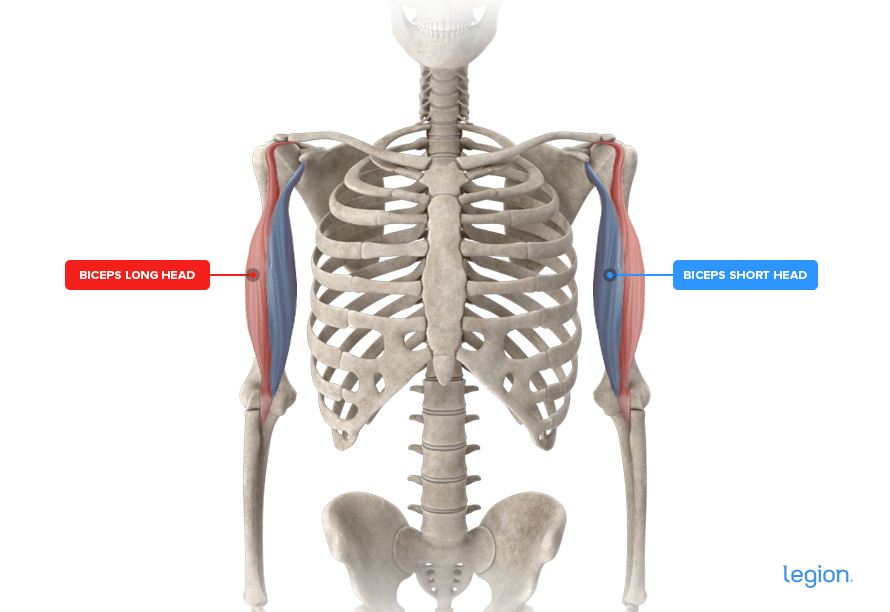
Why Should You Train the Long Head of the Biceps?
Training the long head of the biceps is important for a few reasons.
First, the biceps long head contributes most to your biceps peak. That is, a well-developed biceps long head can help to make your biceps rise higher from your arm when flexed.
Second, doing effective biceps long head exercises strengthens your arms, which can boost your performance on key exercises, such as the pull-up, chin-up, and barbell, dumbbell, and cable row.
And third, a strong long head supports the shoulder joint, which can help prevent injury.
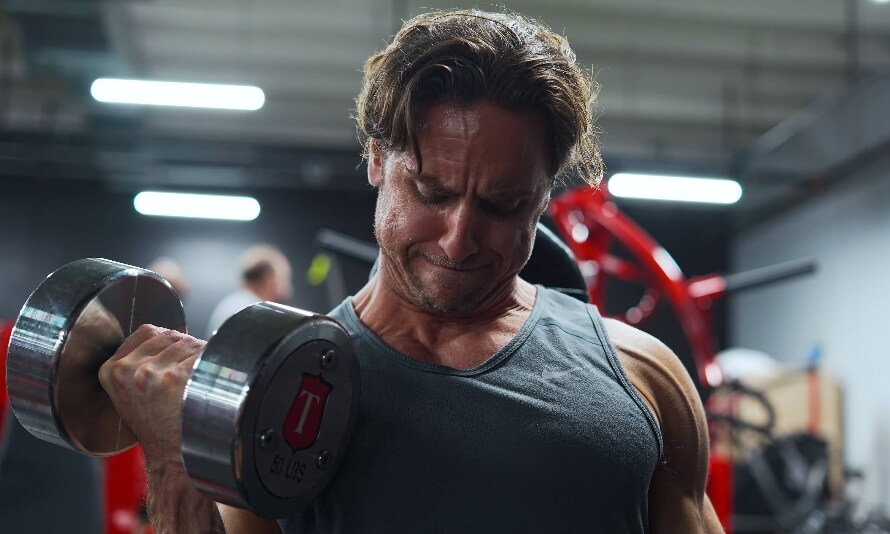
Which Exercises Are for the Biceps Long Head?
While completely isolating the long head of the biceps isn’t possible, certain exercises target the long head more than others.
The long head “crosses” the shoulder joint, so exercises starting with your arms behind your body, like the incline curl, cable curl, and drag curl, tend to be the best long head biceps exercises.
Similarly, research suggests that the long head of the biceps is most active during exercises where you supinate your wrists (turn your palms upward), such as the dumbbell curl, barbell curl, and chin-up.
Many bodybuilders also believe using a narrow grip for biceps exercises emphasizes the long head. While science is yet to support this theory, it’s a low-risk strategy worth trying, provided it doesn’t cause elbow or wrist discomfort or prevent you from using a full range of motion.
The final type of exercise meriting mention is neutral-grip biceps exercises. These exercises don’t train your long heads specifically but emphasize the biceps brachialis, a small muscle that helps to “push” your biceps peak higher.
In other words, neutral-grip biceps exercises aren’t long head biceps exercises per se, but they develop muscles that improve the appearance of your biceps’ long heads, so they’re a good addition to any long head biceps workout.
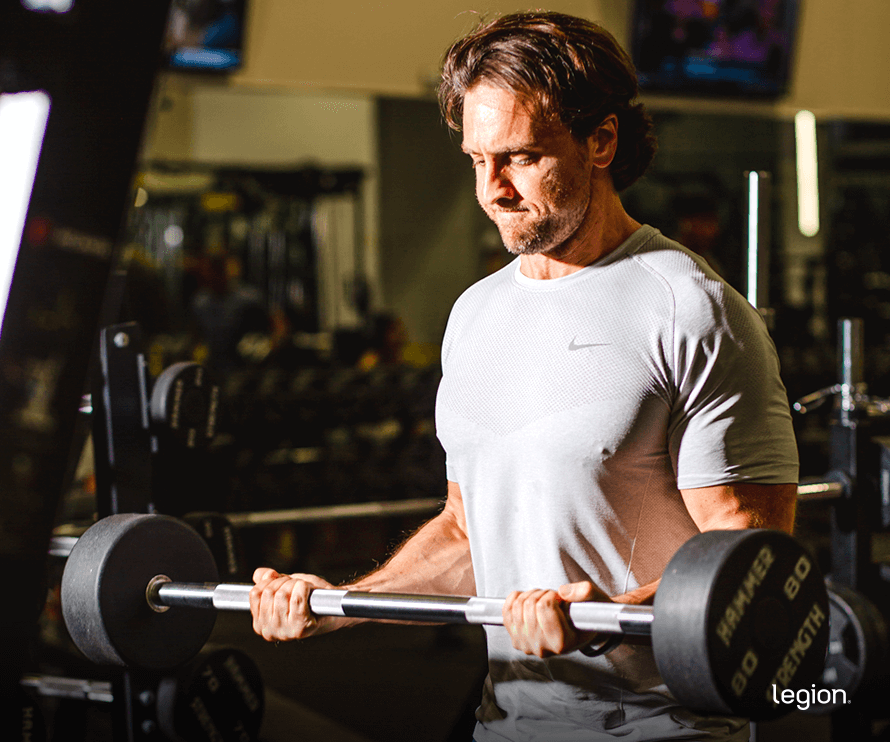
The Best Long Head Biceps Exercises
These are the best bicep long head exercises for adding size to your bis.
1. Chin-up

Why: The chin-up trains your entire biceps to a high degree. Moreover, because it’s a compound exercise, it allows you to lift heavy weights safely and progress regularly, making it an outstanding exercise for the biceps long head.
How to Do the Chin-up:
- Grab a pull-up bar with your hands around shoulder-width apart and your palms facing you.
- Lift your feet so that you’re hanging with your arms straight.
- Pull your body up until your chin is above the bar.
- Once your chin has passed the bar, lower yourself under control to the starting position.
2. Neutral-Grip Pull-up

Why: Similarly to the chin-up, the neutral grip pull-up is a proven biceps builder. Because it involves a neutral grip, it also emphasizes the brachialis, which can help to “lift” your biceps and create a higher peak.
How to Do the Neutral-Grip Pull-up:
- Grab a pull-up bar with your hands around shoulder-width apart and your palms facing each other.
- Lift your feet so that you’re hanging with your arms straight.
- Pull your body up until your chin is above the bar.
- Once your chin has passed the bar, lower yourself under control to the starting position.
3. Incline Dumbbell Curl

Why: The incline dumbbell curl trains your biceps when they’re behind your torso, which emphasizes the long head. It also places high tension on the biceps throughout the entire range of motion, which is important for developing balanced size and strength.
How to Do the Incline Dumbbell Curl:
- While holding a dumbbell in each hand, sit back on an incline bench set to 45 degrees and let your arms hang straight down with your palms facing each other.
- Bend your right elbow to curl the weight toward your right shoulder, rotating your wrist so your palm faces your shoulder at the top of the rep.
- Lower the dumbbell to the starting position, then repeat the pattern with your left hand to complete one full rep.
4. Alternating Dumbbell Curl
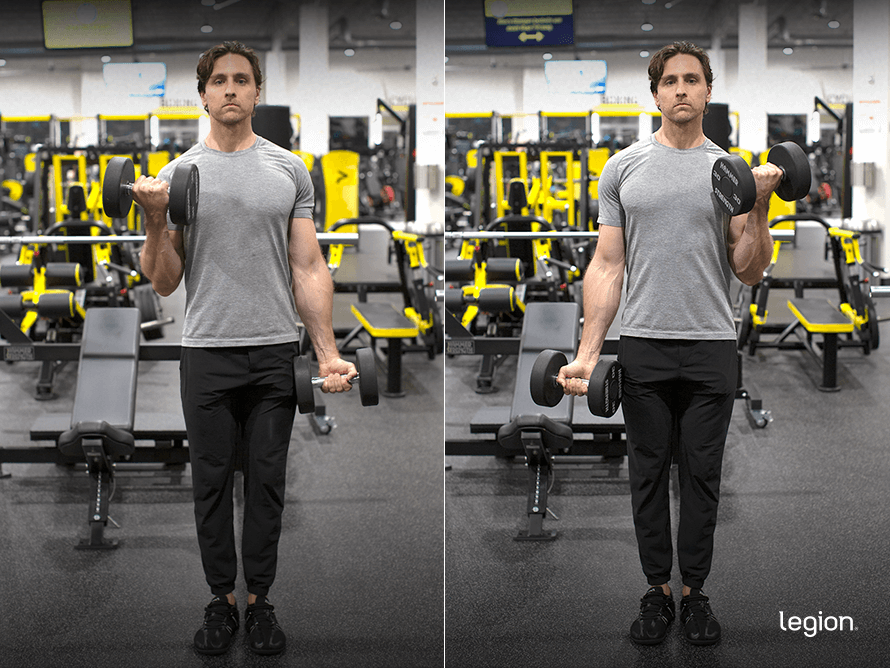
Why: Dumbbell curls are a staple in any biceps training routine for a simple reason: They’re one of the absolute best exercises for training the entire biceps through a full range of motion. They also allow you to fully supinate your wrists, which may maximize biceps long head involvement.
How to Do the Alternating Dumbbell Curl:
- Stand with your feet shoulder-width apart, holding a dumbbell in each hand at your sides and your palms facing your thighs.
- Bend your right elbow to curl your right hand toward your right shoulder, rotating your wrist so your palm faces your shoulder at the top of the rep.
- Reverse the movement and return to the starting position, then repeat the pattern with your left hand to complete one full rep.
5. Hammer Curl
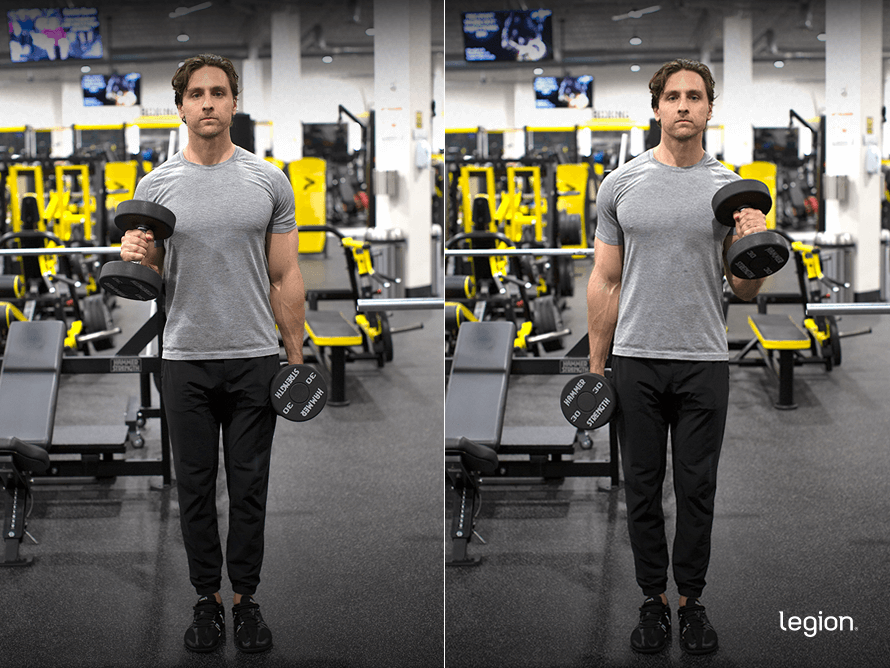
Why: The hammer curl emphasizes the brachialis, a small muscle that can help to push up the biceps brachii, making your upper arms look bigger and improving the appearance of your biceps long heads.
How to Do the Hammer Curl:
- Stand with your feet shoulder-width apart, holding a dumbbell in each hand at your sides and your palms facing your thighs.
- Without twisting your wrist, bend your right elbow to curl your right hand toward your right shoulder.
- Reverse the movement and return to the starting position, then repeat the pattern with your left hand to complete one full rep.
6. Barbell Curl
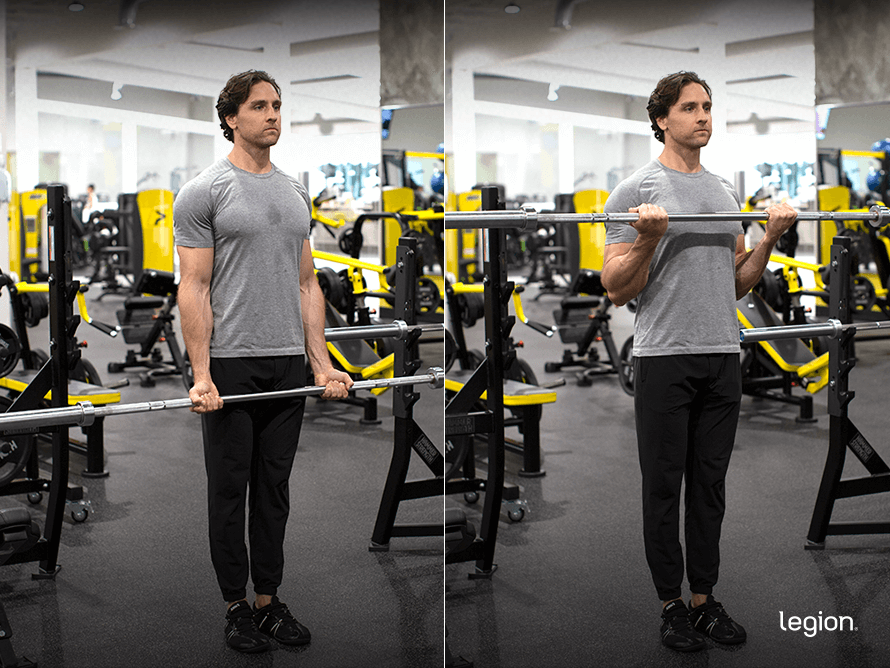
Why: The barbell curl is the most effective barbell long head bicep exercise because it allows you to use maximally heavy weights, which is beneficial for gaining strength and muscle. It also allows you to experiment with a slightly narrower grip, which may increase biceps long head involvement.
How to Do the Barbell Curl:
- While standing up straight, hold a barbell with your palms shoulder-width apart and facing away from you. Your arms should be straight, and the bar should be resting against your thighs.
- Bring the bar up to shoulder height by bending at the elbow.
- Reverse the movement and return to the starting position.
7. Drag Curl
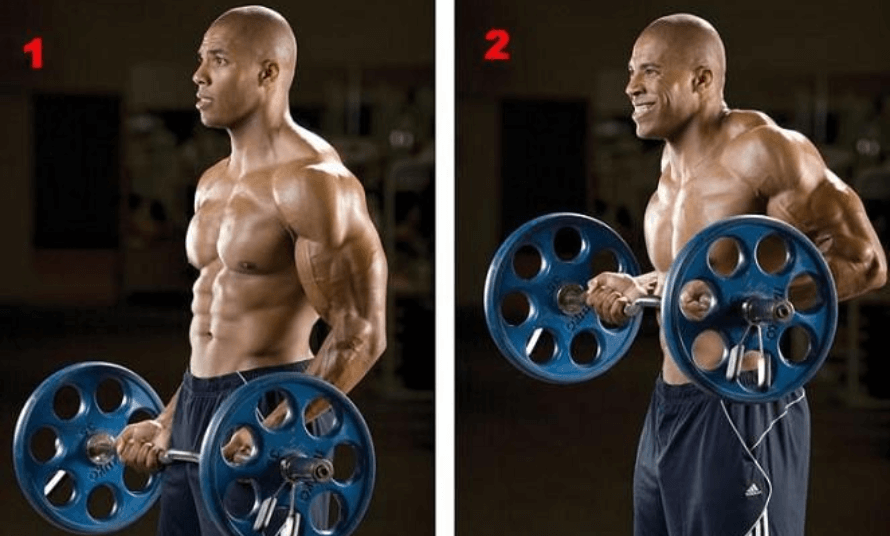
Why: By “dragging” the barbell up your torso, you move your upper arms behind your body, maximizing how much the biceps long head contributes to the exercise. Similarly to the barbell curl, taking a slightly narrower grip than usual may increase how much your biceps’ long heads contribute.
How to Do the Drag Curl:
- While standing up straight, hold a barbell with your palms shoulder-width apart and facing away from you. Your arms should be straight, and the bar should be resting against your thighs.
- Drag the bar up your body by bending your elbows and allowing them to move backward until it’s slightly below nipple height.
- Reverse the movement and return to the starting position.
8. Bayesian Cable Curl
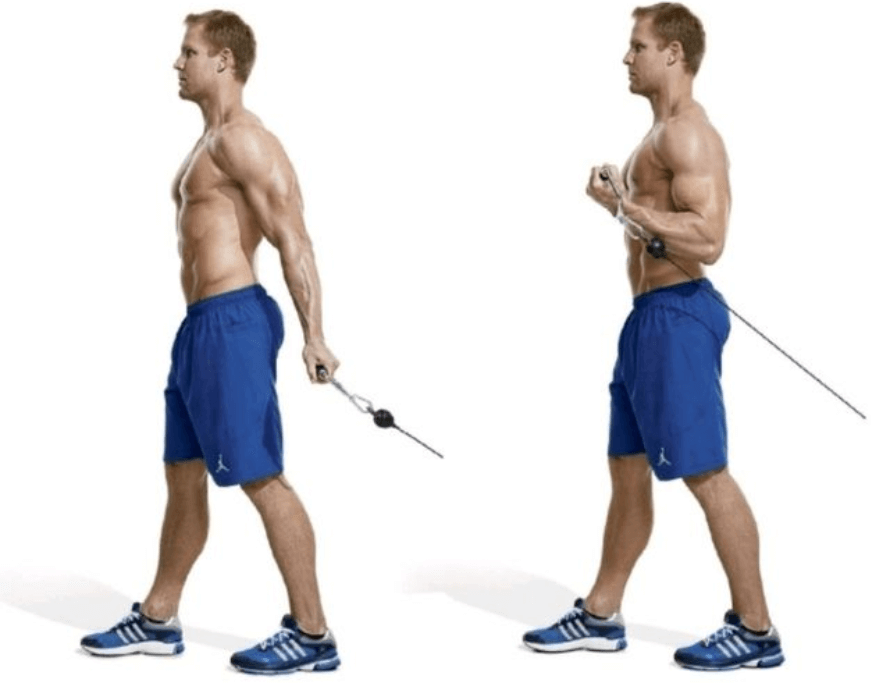
Why: The benefits of the Bayesian curl are that it trains your biceps long head in a stretched position and keeps constant tension on your biceps, both of which benefit growth.
How to Do the Bayesian Cable Curl:
- Set the pulley on a cable machine to the lowest setting and attach a single handle attachment.
- Grab the handle with your right hand, turn away from the pulley, and take 1-to-2 steps forward so the cable pulls your arm slightly behind your body and is taut.
- Stagger your stance, then bend your elbow to curl the handle to your right shoulder. As you curl the weight, lean slightly forward.
- Reverse the movement and return to the starting position. Once you’ve completed the desired number of reps, repeat the process with your left arm.
The Best Workout for the Long Head Biceps
The following workout for the long head of the biceps contains all the best long head biceps exercises and the perfect amount of volume and intensity to spur growth.
Do it once weekly for 8-to-10 weeks, and you should see a significant improvement in your biceps long head size and strength:
- Chin-up: 3 sets of 4-to-6 reps with 2-to-3 min rest
- Incline Dumbbell Curl: 3 sets of 6-to-8 reps with 2-to-3 min rest
- Barbell Curl: 3 sets of 6-to-8 reps with 2-to-3 min rest
- Hammer Curl: 3 sets of 6-to-8 reps with 2-to-3 min rest
Long Head Biceps Workout Tips
1. End every set 1-to-3 reps shy of muscle failure.
As I explain in my fitness books for men and women, to maximize your results, you must take most sets of long head biceps exercises to within a rep or two of failure.
Ask yourself at the end of each set, “If I had to, how many more reps could I have gotten with good form?” If the answer is more than two, increase the weight or reps to make your next set more challenging.
2. Once you hit the top of your rep range for a set, move up in weight.
If your long head biceps workout calls for 6-to-8 reps of the barbell curl and you get 8 reps for a set, add 10 pounds to your next set.
If you manage 3 or fewer reps with the new weight, reduce the weight by 5 pounds to ensure you stay in the 6-to-8 rep range.
Follow this pattern of trying to add reps or weight to every exercise in every workout.
3. Control the eccentric.
Research shows that controlling the eccentric (lowering) portion of a biceps curl is a highly effective way to boost muscle growth.
As a general rule, you should take the same time to lift the weight as you do to lower it to the starting position—around one or two seconds for each is a good target.
4. “Squeeze” your biceps on every rep.
Research shows that using “internal cues” (mental mantras that draw your attention toward what you’re doing with your body) while performing long head biceps exercises may boost biceps growth.
For instance, in a study conducted by scientists at Lehman College, participants increased biceps activation when the researchers reminded them to “squeeze the muscle” during sets of biceps curls.
What’s more, participants who used this cue experienced twice as much biceps growth over the 8-week study as participants who used a cue like “get the weight up.”
5. Take the right supplements.
These supplements can help you get more out of bicep long head exercises:
- Protein powder: Protein powder, such as whey or casein, provides your body with the nutrients needed to build muscle tissue and recover from workouts.
- Creatine: Creatine supplements, such as creatine monohydrate powder and gummies, boost muscle and strength gain, improve anaerobic endurance, and reduce muscle damage and soreness from your workouts.
- Pre-workout: A high-quality pre-workout enhances energy, mood, and focus, increases strength and endurance, and reduces fatigue.
(If you’d like even more specific advice about which supplements you should take to reach your health and fitness goals, take the Legion Supplement Finder Quiz, and in less than a minute, you’ll know exactly what supplements are right for you. Click here to check it out.)

Common Long Head Bicep Exercises Mistakes
1. Lifting too much weight.
Attempting to lift weights that are too heavy can cause your form to break down, reducing the effectiveness of the exercise and increasing the risk of injury.
Avoid this by choosing a weight that allows you to complete each rep with proper form and focus on performing “clean” reps rather than how much weight you lift.
2. Allowing the weight to fall back to the starting position.
Not controlling the weight during the eccentric phase greatly reduces the exercise’s effectiveness. Instead of letting the weight “drop,” take the same time to lift the weight as you do to lower it—about a second for each phase works well.
3. Using momentum.
Relying on momentum to “hump” the weight up reduces the work your biceps do and, thus, how much muscle you gain. To prevent yourself from using momentum, keep your torso and hips still during each rep.

Biceps Long Head Exercises: FAQs
FAQ #1: Do biceps curls work the long head?
Yes, regular biceps curls work the long head of the biceps because they train elbow flexion, which is one of the biceps long head’s primary functions. You can make the biceps curl an even more effective long head biceps exercise by performing it on an incline bench with your arms behind your body.
FAQ #2: What exercise works the long head of the biceps?
All biceps exercises train the biceps long head. However, to emphasize the long head, do exercises that start with your arms behind your body and keep your palms facing up. It may also help to take a narrower grip than usual while performing barbell biceps long head exercises.
Some examples of effective exercises for the biceps long head are the incline dumbbell curl, drag curl, and Bayesian cable curl.
FAQ #3: Can you isolate the biceps long head?
While you can’t completely isolate the long head, exercises that start with your arms behind your body and keep your palms facing up emphasize the biceps long head more than the short head.
FAQ #4: How do you hit all three bicep heads?
The biceps only have two heads (long and short), though the brachialis is another upper-arm muscle that contributes to your biceps’ overall size. To train all these areas of the biceps, perform a variety of pulling and curling exercises that involve different grip orientations and upper are positions.
FAQ #5: What’s the best long head bicep exercise?
There’s no such thing as the “best” long head bicep exercise, though exercises that place your arms behind your body and keep your palms facing up are typically best for developing your biceps long heads.
Scientific References +
- Landin, Dennis, et al. “Actions of the Biceps Brachii at the Shoulder: A Review.” Journal of Clinical Medicine Research, vol. 9, no. 8, 2017, pp. 667–670, https://doi.org/10.14740/jocmr2901w.
- Brughelli, Matt, and John Cronin. “Altering the Length-Tension Relationship with Eccentric Exercise.” Sports Medicine, vol. 37, no. 9, 2007, pp. 807–826, link.springer.com/article/10.2165/00007256-200737090-00004, https://doi.org/10.2165/00007256-200737090-00004.
- Jarrett, Claudius D., et al. “Anatomic and Biomechanical Analysis of the Short and Long Head Components of the Distal Biceps Tendon.” Journal of Shoulder and Elbow Surgery, vol. 21, no. 7, July 2012, pp. 942–948, https://doi.org/10.1016/j.jse.2011.04.030. Accessed 20 Apr. 2021.
- Dickie, James A. , et al. Electromyographic Analysis of Muscle Activation during Pull-up Variations. Nov. 2016, www.researchgate.net/publication/311091421_Electromyographic_analysis_of_muscle_activation_during_pull-up_variations, https://doi.org/10.1016/j.jelekin.2016.11.004.
- Oliveira, Liliam F., et al. “Effect of the Shoulder Position on the Biceps Brachii Emg in Different Dumbbell Curls.” Journal of Sports Science & Medicine, vol. 8, no. 1, 1 Mar. 2009, pp. 24–29, www.ncbi.nlm.nih.gov/pmc/articles/PMC3737788/.
- Farthing, Jonathan P., and Philip D. Chilibeck. “The Effects of Eccentric and Concentric Training at Different Velocities on Muscle Hypertrophy.” European Journal of Applied Physiology, vol. 89, no. 6, 1 Aug. 2003, pp. 578–586, https://doi.org/10.1007/s00421-003-0842-2.
- Schoenfeld, Brad Jon, et al. “Differential Effects of Attentional Focus Strategies during Long-Term Resistance Training.” European Journal of Sport Science, vol. 18, no. 5, 13 Mar. 2018, pp. 705–712, https://doi.org/10.1080/17461391.2018.1447020.
- Stokes, Tanner, et al. “Recent Perspectives Regarding the Role of Dietary Protein for the Promotion of Muscle Hypertrophy with Resistance Exercise Training.” Nutrients, vol. 10, no. 2, 7 Feb. 2018, p. 180, www.mdpi.com/2072-6643/10/2/180/pdf, https://doi.org/10.3390/nu10020180.
- Jd, Branch. “Effect of Creatine Supplementation on Body Composition and Performance: A Meta-Analysis.” International Journal of Sport Nutrition and Exercise Metabolism, 1 June 2003, pubmed.ncbi.nlm.nih.gov/12945830/.
- Eckerson, Joan M., et al. “Effect of Creatine Phosphate Supplementation on Anaerobic Working Capacity and Body Weight after Two and Six Days of Loading in Men and Women.” The Journal of Strength and Conditioning Research, vol. 19, no. 4, 2005, p. 756, https://doi.org/10.1519/r-16924.1.
- Bassit, Reinaldo Abunasser, et al. “Effect of Short-Term Creatine Supplementation on Markers of Skeletal Muscle Damage after Strenuous Contractile Activity.” European Journal of Applied Physiology, vol. 108, no. 5, 3 Dec. 2009, pp. 945–955, https://doi.org/10.1007/s00421-009-1305-1.










